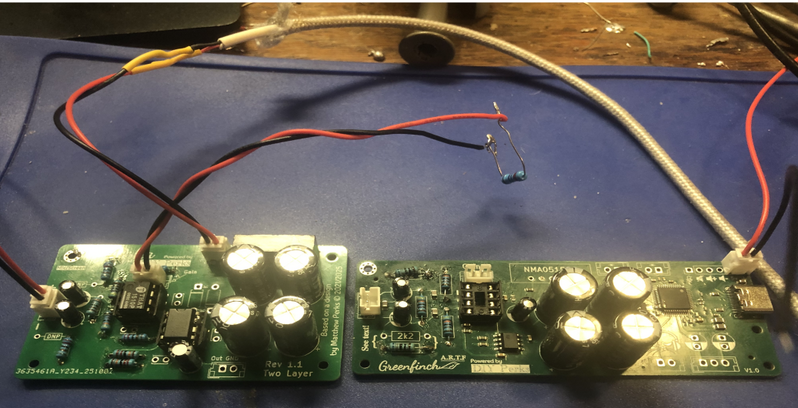@marcdraco Does the usb need data transmission? if not then i found this usb isolator, dont't know whether it will work. https://fiio.com/productinfo/392240.html, or maybe we can make battery powered mic?
Edit: just noticied that it needs data lines, my mistake.....
Don't worry about mistakes, I make more than enough for all of us put together mate. :/
Some things that work (according to the datasheets which is all we have to go on) often don't. Some of the advice is just plain wrong and for someone like me returning from a >40 year hiatus, having to learn CAD layout, SMD and very high-speed mixed signals it's been a baptism of fire.
Take everything I say with a pinch of salt, I might be wrong and it's a very *expensive* way to learn!
this is discontinued, but the ic is still available, and the board looks easy(sort of) to reverse engineer, https://www.audiophonics.fr/en/interface-modules/audiophonics-usb-isolator-module-adum-4160-raspberry-pi-p-8395.html?srsltid=AfmBOoqIuUBWgEsrjBpYVu7UcMq83LvoUn7Vpw3nhXsTQV9q73TRB-gf
i also found these, https://www.amazon.com/Topping-Isolator-Compatible-PCM32bit-withstands/dp/B09MF9VTQG
https://www.aliexpress.com/item/1005001369085297.html
Edit: fixed the link.
Don't think this would work, it's USB 2.0 and doesn't support the USB 1.1 that the digitiser works at - although it does raise an interesting issue (ground lifters).
Ground loops are what amount to little aerials. Radiation from mains wiring (this happens all the time) causes several points with a different "ground reference" due to the different impedance in each leg and that causes the ground to "wobble" at the mains frequency.
This translates to hum at the output because all the amplifiers across the entire system have to follow the ground. A few mV of wobble in a power amplifier isn't going to be that bad because they rarely have any actual voltage gain. Wobble on the the pre-amps, where there is a voltage gain 100x, 1000x or more, means that the output follows the hum - and that gets onto your speakers, headphones, etc.
This problem is particularly annoying for live performers with many using a dangerous botch of disconnecting the equipment from their protective earth - which is usually also connected to the ground reference. The difference is that the ground reference is local to the circuit (think something powered from a battery) whereas the protective earth is connected to a huge piece of metal buried in the foundations. Should the live connection from the mains come adrift and hit the earth terminal, something that while rare, can happen, there is nowhere for the current to flow - until a performer comes along and completes the circuit by (for example) touching a microphone.
Earth connections are there for a reason.
The safe solution is to use an isolation transformer which galvanically isolates the building mains from the mains current driving the equipment. These transformers create a mains level voltage (1:1) but without a ground referenced to the incoming live, so simply touching the live wire won't deliver a potentially lethal shock. You can still get killed by an isolation transformer - it's still mains level voltage - but not by simply touching a ground.
EDIT:
Here's quickie that illustrates the problem. Here's a spice simulation of these noise pulses on a typical 5V line with a 10 uF capacitor (green), a 1000 uF (blue) and 4.4 mF (red) per Matt's original. It's a real bind the USB inventors didn't attend to this issue which would have be present since the earliest invocations, but it's what we have to deal with.
Take everything I say with a pinch of salt, I might be wrong and it's a very *expensive* way to learn!
This supports usb 1.1, but it requires a separate power supply.
Makes sense that it would - but ground lifting doesn't help the crud on the 5V line - see the edited post above for the real issue we're dealing with.
Take everything I say with a pinch of salt, I might be wrong and it's a very *expensive* way to learn!
this is discontinued, but the ic is still available, and the board looks easy(sort of) to reverse engineer, https://www.audiophonics.fr/en/interface-modules/audiophonics-usb-isolator-module-adum-4160-raspberry-pi-p-8395.html?srsltid=AfmBOoqIuUBWgEsrjBpYVu7UcMq83LvoUn7Vpw3nhXsTQV9q73TRB-gf
You're right and this is the sort of thing we really need. Looks like AD had the solution all along and yes, it's quite straightforward to make our own. It's not the cheapest of chips but JLC does stock it (it lists 1800 or so in stock right now).
I'll see what I can cook up from the datasheet. 🙂
Take everything I say with a pinch of salt, I might be wrong and it's a very *expensive* way to learn!
Hi all, I haven't posted an update of late - mostly life getting the way, so I thought I'd better let everyone know that while it's moving like a drunken snail, things are moving.
There are two boards here on my testing harness. Left is "Alpha" which is an improved version of Matt's original still under development. It works as shown here but I felt there was still room for a few tweaks like regulators. This is a PCB only, two layer and no vias so it could be made at home if you have the gear. Cost from JLC is a few £s plus shipping. BOM is similar. The additional parts are common ones you can get on eBay or even might have in your parts bin if you've been at this for a while. Positions and values are marked on the board for everything but the smallest parts.
On the right on this image is something I've been working on since late last year, yes I'm that slow. This integrates the Alpha with a complete headset digitiser and USB-C port. The digital section is SMD (and rather difficult to make at home) but the left of the board is almost identical to Matt's original BOM.
Spotted an extra 8-pin IC? That's a JFET op amp like a TL072 - but any FET input dual will work here. The current version (not shown) has a tracking adjustment to vary the output swing from 0 - which is pretty useless all the way to 2.5V peak, so it will drive pretty much any digitiser including those TV ones.
So where are the plans? Well to date, I'm not 100% happy with the performance of Greenfinch (the larger one) and I'm holding off until I've built a prototype for the upgraded Alpha. The current one doesn't have adjustable output and that is something it needs to prevent blowing up digitiser boards that don't have protection diodes. Hence it's still all experimental.
Take everything I say with a pinch of salt, I might be wrong and it's a very *expensive* way to learn!



